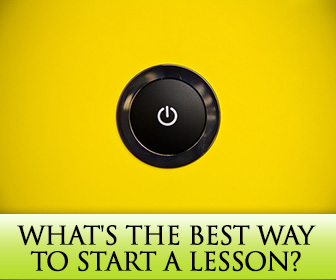“I have a pretty good idea of ways to start class on the very first day of school. But where do I go from there? How do I begin each subsequent lesson? I don’t want to simply jump into the day’s material.” *
This person is absolutely right. You don’t want to dive in headfirst into your lesson without some sort of warm-up activity.
Lots of ESL teachers simply resort to small talk, ask questions about students’ weekend activities or recent events. And that’s fine. But you can also give your class a much better warm up, one that will effectively prepare them for what’s coming next: a series of engaging activities that will take their English communication skills to the next level! Here are some great options you might want to consider.

7 Ideas for Fabulous Lesson Warm Ups
-
1
Make it a Habit
One really great way to start a lesson is with a single activity you can establish as a habit for every lesson that follows. For example, with my youngest learners, we always started each and every lesson with a song – the same song for an entire semester, then we switched and learned a different one. It was our way of greeting each other, and it marked the official start of the lesson. Needless to say, young children thrive on habits and routines, and it’s really helpful to have solid routines in place!
For older ESL students, you may also choose one activity with which to start the lesson. Start the day with a “What’s New?” segment. Ask adult ESL learners to share a piece of news they’ve heard over the weekend. Or start each class with a different Tongue Twister to loosen up those lazy tongues.
-
2
Make it Visual
What will you be talking about in the day’s lesson? The seasons and the weather? Start the class by introducing the topic with a picture, photo or even a video. Warm ups are great ways to get students to start thinking about the day’s topic.
-
3
Make it a Review
Did your class learn a bunch of new words last time? Vocabulary related to health? Show photos of sick people and describe their symptoms; have your students diagnose the patients.
-
4
Make it a Game
Who says you can’t start the lesson with a game? Games are great ways to review what students learned in previous lessons, plus they’re highly effective for getting students motivated from the get-go. Play a card game to review vocabulary or a verb ping pong, where one student says a verb and another has to say it in past (or use it in a specific tense). Because we’re talking about warm ups here, I recommend that you keep it short – just a 5 or 10-minute activity.
-
5
Make it Active
Does it make sense to get your class out of their seats just seconds after they sit down? Absolutely! Everyone understands the importance of a warm up before physical activity, and even though learning English is not a physical activity per se, it’s always a good idea to get hearts pumping and students stretching their muscles to prepare for a lesson filled with activity. Warm ups that involve a TPR (Total Physical Response) set the tone, and students know what to expect from the lesson, or at the very least they know what not to expect: to be sitting for the duration of the class.
-
6
Make it Conversational
In far too many cases, students enter the ESL classroom and immediately open a book. Why not start with a speaking activity? Present a discussion topic, a conversation starter or an ice breaker – anything to get them speaking!
-
7
Make it Specific
Say you’ve planned your lesson with a specific goal in mind, like “Making plans with friends”. Another great warm-up activity is to introduce the topic and have the class define a more specific, targeted goal. So towards the end of the warm up, their new lesson goal will be something like, “Making plans to go out with friends on Friday night”. You’ll carry out all of the activities as planned (no need to change your lesson plan), but your students will know that by the end of the lesson they’ll be able to do this. (And it’s a good idea to close the lesson with a role play that confirms the achievement of the goal.)
We already give students a warm up before each listening activity and every speaking, reading or writing task – is it really necessary to give them a warm up at the start of the lesson? Well, it may not be absolutely necessary, but it certainly helps set the mood and the tone for the day’s work. You may feel tempted to dive right into your lesson, but let your students dip their toes first. They’ll be doing swimmingly from then on!
P.S. If you enjoyed this article, please help spread it by clicking one of those sharing buttons below. And if you are interested in more, you should follow our Facebook page where we share more about creative, non-boring ways to teach English.







